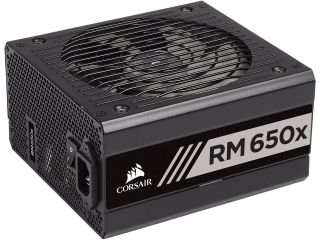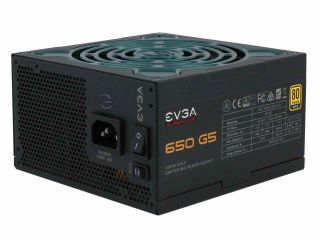Why you can trust Tom's Hardware
To learn more about our PSU tests and methodology, please check out How We Test Power Supply Units.
Primary Rails And 5VSB Load Regulation
The following charts show the main rails' voltage values recorded between a range of 40W up to the PSU's maximum specified load, along with the deviation (in percent). Tight regulation is an important consideration every time we review a power supply because it facilitates constant voltage levels despite varying loads. Tight load regulation also, among other factors, improves the system’s stability, especially under overclocked conditions and, at the same time, it applies less stress to the DC-DC converters that many system components utilize.

Results 1-8: Load Regulation







The load regulation is tight on the +12V, 5V and 3.3V rails and within 3% at 5VSB.
Hold-Up Time
Put simply; hold-up time is the amount of time that the system can continue to run without shutting down or rebooting during a power interruption.

Results 9-12: Hold-Up Time





The hold-up time is longer than 20ms, and the power-ok signal is accurate.
Inrush Current
Inrush current, or switch-on surge, refers to the maximum, instantaneous input current drawn by an electrical device when it is first turned on. A large enough inrush current can cause circuit breakers and fuses to trip. It can also damage switches, relays, and bridge rectifiers. As a result, the lower the inrush current of a PSU right as it is turned on, the better.

Results 13-14: Inrush Current

The registered inrush currents are at normal levels.
10-110% Load Tests
These tests reveal the PSU's load regulation and efficiency levels under high ambient temperatures. They also show how the fan speed profile behaves under increased operating temperatures.
| Test # | 12V | 5V | 3.3V | 5VSB | DC/AC (Watts) | Efficiency | Fan Speed (RPM) | PSU Noise (dB[A]) | Temps (In/Out) | PF/AC Volts |
| 1 | 3.583A | 1.999A | 1.989A | 0.980A | 65.022 | 84.513% | 0 | <6.0 | 45.07°C | 0.951 |
| 12.116V | 5.006V | 3.318V | 5.106V | 76.937 | 39.34°C | 115.18V | ||||
| 2 | 8.137A | 3.002A | 2.987A | 1.178A | 129.511 | 88.832% | 0 | <6.0 | 46.60°C | 0.977 |
| 12.117V | 5.001V | 3.315V | 5.093V | 145.794 | 40.53°C | 115.18V | ||||
| 3 | 13.088A | 3.504A | 3.473A | 1.378A | 194.639 | 89.971% | 331 | 7.6 | 40.97°C | 0.986 |
| 12.120V | 4.997V | 3.312V | 5.080V | 216.336 | 47.45°C | 115.18V | ||||
| 4 | 18.041A | 4.005A | 3.988A | 1.579A | 259.865 | 90.109% | 813 | 24.6 | 41.38°C | 0.988 |
| 12.120V | 4.995V | 3.310V | 5.068V | 288.389 | 48.30°C | 115.18V | ||||
| 5 | 22.665A | 5.009A | 4.990A | 1.781A | 325.164 | 89.909% | 684 | 19.6 | 42.23°C | 0.990 |
| 12.118V | 4.992V | 3.307V | 5.055V | 361.659 | 49.54°C | 115.17V | ||||
| 6 | 27.225A | 6.018A | 5.994A | 1.984A | 389.684 | 89.481% | 852 | 25.5 | 42.76°C | 0.991 |
| 12.116V | 4.988V | 3.304V | 5.042V | 435.492 | 50.62°C | 115.17V | ||||
| 7 | 31.848A | 7.025A | 6.999A | 2.189A | 454.998 | 88.928% | 862 | 25.8 | 43.48°C | 0.991 |
| 12.116V | 4.985V | 3.301V | 5.027V | 511.645 | 52.08°C | 115.17V | ||||
| 8 | 36.469A | 8.034A | 8.005A | 2.394A | 520.308 | 88.363% | 891 | 26.6 | 43.67°C | 0.992 |
| 12.117V | 4.980V | 3.298V | 5.014V | 588.833 | 53.20°C | 115.17V | ||||
| 9 | 41.492A | 8.544A | 8.499A | 2.398A | 585.237 | 87.722% | 1157 | 33.6 | 44.23°C | 0.992 |
| 12.116V | 4.976V | 3.295V | 5.005V | 667.147 | 54.40°C | 115.17V | ||||
| 10 | 46.258A | 9.055A | 9.024A | 3.011A | 650.084 | 86.964% | 1459 | 40.1 | 45.82°C | 0.993 |
| 12.114V | 4.971V | 3.291V | 4.983V | 747.529 | 56.73°C | 115.17V | ||||
| 11 | 51.618A | 9.064A | 9.036A | 3.016A | 714.922 | 86.257% | 1784 | 45.3 | 46.60°C | 0.993 |
| 12.112V | 4.967V | 3.287V | 4.974V | 828.832 | 58.28°C | 115.17V | ||||
| CL1 | 0.158A | 12.002A | 12.001A | 0.000A | 101.506 | 84.522% | 366 | 8.5 | 42.55°C | 0.972 |
| 12.131V | 4.993V | 3.305V | 5.103V | 120.094 | 49.90°C | 115.19V | ||||
| CL2 | 54.024A | 1.003A | 1.001A | 1.000A | 667.674 | 87.431% | 1562 | 41.6 | 46.07°C | 0.993 |
| 12.112V | 4.978V | 3.297V | 5.042V | 763.658 | 57.03°C | 115.17V |
The power supply can handle high operating temperatures, which exceed 45 degrees Celsius. Moreover, despite the harsh conditions, the PSU is very close to the 80 PLUS Gold efficiency requirements.
20-80W Load Tests
In the following tests, we measure the PSU's efficiency at loads significantly lower than 10% of its maximum capacity (the lowest load the 80 PLUS standard measures). This is important for representing when a PC is idle with power-saving features turned on.
| Test # | 12V | 5V | 3.3V | 5VSB | DC/AC (Watts) | Efficiency | Fan Speed (RPM) | PSU Noise (dB[A]) | PF/AC Volts |
| 1 | 1.209A | 0.501A | 0.480A | 0.195A | 19.747 | 69.854% | 0 | <6.0 | 0.787 |
| 12.106V | 5.016V | 3.326V | 5.131V | 28.269 | 115.18V | ||||
| 2 | 2.460A | 1.000A | 0.994A | 0.391A | 40.098 | 80.381% | 0 | <6.0 | 0.907 |
| 12.108V | 5.009V | 3.321V | 5.124V | 49.885 | 115.18V | ||||
| 3 | 3.651A | 1.499A | 1.477A | 0.587A | 59.627 | 84.391% | 0 | <6.0 | 0.945 |
| 12.110V | 5.008V | 3.320V | 5.116V | 70.656 | 115.18V | ||||
| 4 | 4.904A | 2.000A | 1.989A | 0.783A | 80.013 | 86.680% | 0 | <6.0 | 0.963 |
| 12.113V | 5.006V | 3.318V | 5.109V | 92.309 | 115.18V |
It would be nice to see higher than 70% efficiency with 20W load. In the other three tests, the efficiency levels exceed the 80% mark.
2% or 10W Load Test
Intel plans on raising the ante at efficiency levels under ultra-light loads. So from July 2020, the ATX spec will require 70% and higher efficiency with 115V input. The applied load is only 10W for PSUs with 500W and lower capacities, while for stronger units we dial 2% of their max-rated-capacity.
| Test # | 12V | 5V | 3.3V | 5VSB | DC/AC (Watts) | Efficiency | Fan Speed (RPM) | PSU Noise (dB[A]) | PF/AC Volts |
| 1 | 0.933A | 0.208A | 0.203A | 0.051A | 13.267 | 61.197% | 0 | <6.0 | 0.698 |
| 12.096V | 5.020V | 3.329V | 5.136V | 21.679 | 115.18V |
The PSU cannot reach (or exceed) 70% efficiency with 2% of its max-rated-capacity load. This means that it won't meet the upcoming, in a few months, ATX spec requirement.
Efficiency
Next, we plotted a chart showing the PSU's efficiency at low loads, and loads from 10 to 110% of its maximum-rated capacity. The higher a PSU’s efficiency, the less energy goes wasted, leading to a reduced carbon footprint and lower electricity bills.

Results 15-18: Efficiency




Compared to products with similar specifications, the efficiency at normal and light loads is at average levels, while with super-light loads, it is quite low.
5VSB Efficiency
| Test # | 5VSB | DC/AC (Watts) | Efficiency | PF/AC Volts |
| 1 | 0.100A | 0.514 | 72.191% | 0.110 |
| 5.136V | 0.712 | 115.17V | ||
| 2 | 0.250A | 1.284 | 75.485% | 0.221 |
| 5.133V | 1.701 | 115.17V | ||
| 3 | 0.550A | 2.820 | 76.672% | 0.334 |
| 5.126V | 3.678 | 115.17V | ||
| 4 | 1.000A | 5.118 | 77.125% | 0.403 |
| 5.116V | 6.636 | 115.17V | ||
| 5 | 1.500A | 7.660 | 76.954% | 0.438 |
| 5.105V | 9.954 | 115.16V | ||
| 6 | 3.000A | 15.209 | 75.303% | 0.483 |
| 5.069V | 20.197 | 115.16V |

Results 19-20: 5VSB Efficiency

The 5VSB rail's efficiency is low.
Power Consumption In Idle And Standby
| Mode | 12V | 5V | 3.3V | 5VSB | Watts | PF/AC Volts |
| Idle | 12.089V | 5.023V | 3.331V | 5.138V | 7.791 | 0.553 |
| 115.2V | ||||||
| Standby | 0.056 | 0.009 | ||||
| 115.2V |

Results 21-22: Vampire Power

The vampire power levels are quite low.
Fan RPM, Delta Temperature, And Output Noise
All results are obtained between an ambient temperature of 37 to 47 degrees Celsius (98.6 to 116.6 degrees Fahrenheit).
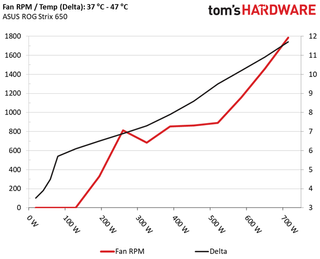

The fan profile is quite loose, even at high operating temperatures. This is possible thanks to the large heat sinks, which effectively handle the (not so high) thermal loads.
The following results were obtained at 30 to 32 degrees Celsius (86 to 89.6 degrees Fahrenheit) ambient temperature.
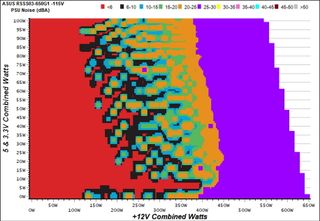
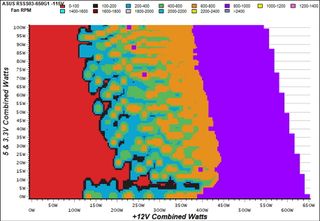
The fan profile doesn't last long, and even in the worst-case scenario, the fan's noise remains below 30 dB(A).
MORE: Best Power Supplies
MORE: How We Test Power Supplies
MORE: All Power Supply Content
Current page: Load Regulation, Hold-Up Time, Inrush Current, Efficiency and Noise
Prev Page Specifications and Part Analysis Next Page Protection Features, DC Power Sequencing, Cross-Load Tests and Infrared ImagesAris Mpitziopoulos is a Contributing Editor at Tom's Hardware US, covering PSUs.


